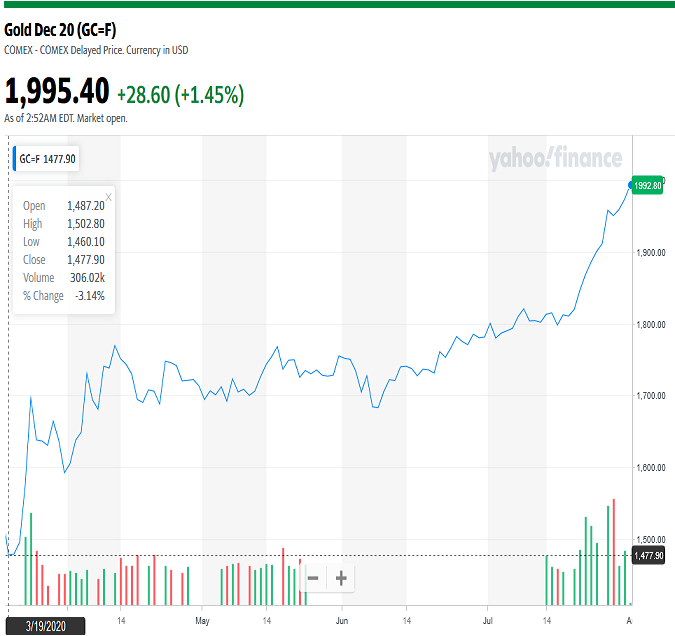Giuseppe Sandro Mela.
2020-07-31.
«These were by far the sharpest declines observed
since time series started in 1995»
* * * * * * *
Tutti i dati macroeconomici dell’occidente e dei paesi occidentalizzati evidenziano con chiarezza come la crisi da coronavirus sia stata solo l’elemento scatenante di una recessione economica dovuta ai problemi sociali, politici, strutturali ed economici di questo settore del mondo.
Elemento comune a tutti questi paesi è la presenza di immani debiti pubblici, arrivati adesso al limite della gestibilità. È È anche in corso una parcellizzazione del quadro politico, elemento questo che concorre a rendere ancora più instabile la gestione della cosa pubblica.
Nonostante sia passato molto tempo, l’Unione Europea non è ancora riuscita ad approvare in via definitiva il proprio budget settennale, ed i fondi a sostegno dell’economia non sono ancora stati ratificati dall’europarlamento.
L’Unione Europea sta vivendo in una palude decisionale, cullandosi nelle proprie illusioni, per non definirle più propriamente come allucinazioni.
Un esempio per tutti, i titoli del giorno 31 luglio di Eu Observer.
First use of new EU sanctions against Russia, China hackers
Six ‘LGBTI-free’ Polish cities left out of EU funding
Polish tribunal to examine EU gender-violence treaty
Why is building renovation ‘Cinderella’ of EU Green Deal?
Migrant healthcare must not be forgotten during Covid-19
Eight in ten people are concerned about climate change
Poland might still uphold gender-violence treaty
Non un rigo sui cogenti problemi economici dell’Unione: sembrerebbe che gli unici argomenti degni di discussione siano quelli sessuali oppure quelli del ‘clima’.
L’occidente si è avviato verso il suo suicidio culturale, sociale, politico ed economico.
*
Eurostat ha rilasciato il Report
GDP down by 12.1% in the euro area and by 11.9% in the EU.
Preliminary flash estimate for the second quarter of 2020
GDP down by 12.1% in the euro area and by 11.9% in the EU
-15.0% and -14.4% respectively compared with the second quarter of 2019
In the second quarter 2020, still marked by COVID-19 containment measures in most Member States, seasonally adjusted GDP decreased by 12.1% in the euro area and by 11.9% in the EU, compared with the previous quarter, according to a preliminary flash estimate published by Eurostat, the statistical office of the European Union. These were by far the sharpest declines observed since time series started in 1995. In the first quarter of 2020, GDP had decreased by 3.6% in the euro area and by 3.2% in the EU.
These preliminary GDP flash estimates are based on data sources that are incomplete and subject to further revisions under the COVID-19 containment measures. The next estimates for the second quarter of 2020 will be released on 14 August 2020.
Compared with the same quarter of the previous year, seasonally adjusted GDP decreased by 15.0% in the euro area and by 14.4% in the EU in the second quarter of 2020, after -3.1% and -2.5% respectively in the previous quarter. These were also by far the sharpest declines since time series started in 1995.
Among the Member States, for which data are available for the second quarter 2020, Spain (-18.5%) recorded the highest decline compared to the previous quarter, followed by Portugal (-14.1%) and France (-13.8%). Lithuania (-5.1%) recorded the lowest decline.
Geographical information.
Euro area (EA19): Belgium, Germany, Estonia, Ireland, Greece, Spain, France, Italy, Cyprus, Latvia, Lithuania, Luxembourg, Malta, the Netherlands, Austria, Portugal, Slovenia, Slovakia and Finland.
European Union (EU27): Belgium, Bulgaria, Czechia, Denmark, Germany, Estonia, Ireland, Greece, Spain, France, Croatia, Italy, Cyprus, Latvia, Lithuania, Luxembourg, Hungary, Malta, the Netherlands, Austria, Poland, Portugal, Romania, Slovenia, Slovakia, Finland and Sweden.
*
Bbc. Eurozone suffers deepest contraction on record.
Spain has been plunged into its deepest recession in modern times by the coronavirus pandemic.
Its economy shrank by 18.5% in the April-to-June period, having already fallen by 5.2% in the first three months of the year.
The country was the worst performer in the eurozone, which saw its overall GDP decline by a record 12.1%.
France’s economy has also been badly hit, with GDP there falling by 13.8% in the second quarter.
The French statistics agency said the low point had come in April, with a gradual recovery in May and June as lockdown restrictions eased, but economic activity was still well below normal.
Italy, which was among the first European countries to be hit by the pandemic, has reported a similar drop, with the economy contracting by 12.4%. However, the fall was less steep than expected.
Across the EU, the economic contraction was 11.9%.
The official Eurostat agency said the falls were the largest since it began recording the figures in 1995.
The US and Germany both announced huge falls in national output on Thursday, showing the global economic impact of Covid-19.
The US saw its sharpest contraction in decades, with the economy shrinking at an annual rate of 32.9% between April and June.
Germany reported its deepest quarterly decline on record, as total production of goods and services fell by 10.1%.
The Spanish figures, which were worse than forecast, have wiped out the growth of the past six years.
Economic activity in Spain has declined by a total of more than a fifth so far this year. Service industries including transport, restaurants and accommodation have been hardest hit, as they have been most affected by the restrictions on movement imposed to fight the pandemic.
Spain has suffered a large number of deaths in the course of the health crisis, and a correspondingly dramatic impact on the economy was seen as inevitable, says BBC World Service economics correspondent Andrew Walker.
Our correspondent adds that although many of the restrictions on commercial activity in Spain have now been eased, any rebound is sure to be impaired by the recent resurgence of coronavirus infections in some areas.












